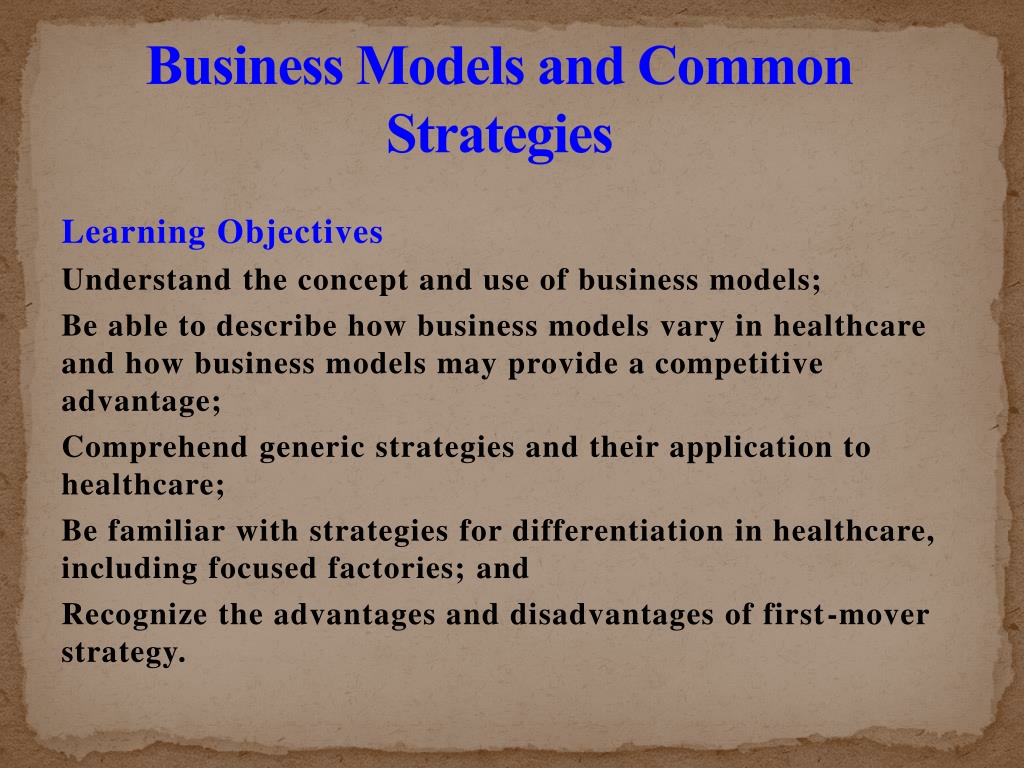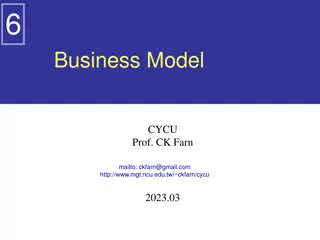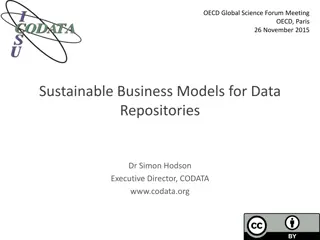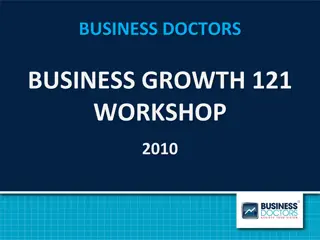Understanding Business Models and Strategies in Healthcare
This content explores the significance of business models and common strategies in healthcare, emphasizing the importance of value creation for patients and other stakeholders. It covers topics such as internal environmental analysis, differentiation strategies, and the concept of first-mover strategy. The examples provided illustrate how perceived value in healthcare services is not solely determined by price but also by factors like satisfaction and quality.
Download Presentation

Please find below an Image/Link to download the presentation.
The content on the website is provided AS IS for your information and personal use only. It may not be sold, licensed, or shared on other websites without obtaining consent from the author. Download presentation by click this link. If you encounter any issues during the download, it is possible that the publisher has removed the file from their server.
E N D
Presentation Transcript
Business Models and Common Strategies Learning Objectives Understand the concept and use of business models; Be able to describe how business models vary in healthcare and how business models may provide a competitive advantage; Comprehend generic strategies and their application to healthcare; Be familiar with strategies for differentiation in healthcare, including focused factories; and Recognize the advantages and disadvantages of first-mover strategy.
Business Models and Common Strategies Internal environmental analysis is sometimes accomplished by evaluating functional areas such as clinical operations, information systems, marketing, clinical support, human resources, financial administration, and so on. With such an approach, each function or organizational subsystem is carefully analyzed and a list of strengths and weaknesses is developed and evaluated. Although this approach has been successful in some instances, by itself it does not adequately address strategic issues.
Business Models and Common Strategies Value Creation in Health Care Organizations Organizations are successful when they create value for their customers. Similarly health care organizations are successful to the extent that they create value for the patients, physicians, and other stakeholders that rely on their services. Value is defined as the amount of satisfaction received relative to the price paid for a health care service.
Business Models and Common Strategies Value Creation in Health Care Organizations For example, a patient may go to a cosmetic surgeon and pay an extremely high price. Despite the high price, the perception of social acceptance, increased feeling of self-esteem and improved self-confidence may provide so much satisfaction that the patient believes a very high value was received.
Business Models and Common Strategies Value Creation in Health Care Organizations By contrast, patients may go to a family practice clinic where services are provided in a rude and disrespectful manner and perceive that they have received little or no value. Value is the perceived relationship between satisfaction and price, not price alone. The value chain as a strategic thinking map provides the health care strategist with a framework for assessing the internal environment of the organization.
Business Models and Common Strategies Organizational Value Chain Health care organizations have numerous opportunities to create value for patients and other stakeholders. For example, efficient appointment systems, courteous doctors and nurses, patient friendly billing systems, easy-to-navigate physical facilities, and the absence of bureaucratic red tape can greatly increase the ratio of satisfaction to price.
Business Models and Common Strategies Organizational Value Chain The organizational value chain is an effective means of illustrating how and where value may be created. The value chain illustrated in Exhibit 4 1 has been adapted from the value chain used in industrial organizations to more closely reflect the value adding components for health care organizations.
Business Models and Common Strategies Organizational Value Chain The value chain utilizes a systems approach; value may be created in the service delivery subsystem (upper portion of the value chain) and by effective use of the support subsystem (lower portion). Service delivery activities (pre-service, point-of- service, and after-service) are placed above the support activities as they are the fundamental value creation activities but they are supported by, activities that facilitate and improve service delivery.
Business Models and Common Strategies Organizational Value Chain The three elements of service delivery pre- service, point-of-service, and after-service incorporate the production or creation of the service (product) of health care and include primarily operational processes and marketing activities.
Business Models and Common Strategies Organizational Value Chain Organizational culture, organizational structure, and strategic resources are the subsystems that support service delivery by ensuring an inviting and supportive atmosphere, an effective organization, and sufficient resources such as finances, highly qualified staff, information systems, and appropriate facilities and equipment. Although not always apparent, such support systems are critical for an effective and efficient organization.
Business Models and Common Strategies http://www.vantageleadership.com/wp-content/uploads/2015/04/business-model.jpg Business Models
Business Models and Common Strategies Business Models Whatever their definition of success, organizations constantly face the challenge of devising strategies that will enable them to enhance the value they provide to their key stakeholders. Business models, the underlying structure and function of organizations, build on the idea of value chains and value creation.
Business Models and Common Strategies Business Models Defined as the core elements of an organization and how it is structured to deliver value to its customers and generate revenues. A company s business model describes its collaborative portfolio of strategy choices put in place for the handling of the processes and relationships that drive value creation on operational, tactical and executive levels.
The MOH Strategic Plan will Transfer the Healthcare System in Saudi Arabia from Hospital Centered Health System to Health Needs of Rostered Population
Business Models and Common Strategies Business Models Business models encompass all aspects of organizations, including their economic, operational, and strategic domains, and successful organizations design their business models around their internal competencies. http://blog.curemd.com/wp-content/uploads/2014/07/How-small-practices-can-prepare-for-the-shift-from-Volume-to-Value-based-Care.png
Business Models and Common Strategies Business Models Appropriate, competitive business models often succeed when matched against organizations that have better ideas and better technology but a poor business model. Most established organizations in the same industry do not have distinct business models. Organizations that compete for the same set of customers frequently copy each other s structures and strategies. Over time, many organizations may come to offer similar sets of products and services.
Business Models and Common Strategies Business Models Barriers commonly restrict entry into an industry, and mobility barriers limit competition within strategic groups. With limited entry of new organizations and similar environmental conditions, incumbents become isomorphic over time, adopting homogenous forms and practices. They look different, nonetheless they are basically the same. http://www.beva.org/maen50980/Unit06/images/griso.gif
Business Models and Common Strategies Business Models As a result, pronounced differences in business models often emerge only when environmental shifts alter customer preferences, technology, and barriers to entry, thereby allowing new organizations to enter the industry.
Business Models and Common Strategies Business Models Business models are often portrayed as four interrelated components: value to customers, organizational inputs, organizational processes, and means of generating and obtaining revenues (see Exhibit 3.2). The content and structure of these components should result from strategic decisions; their functions and interactions importantly contribute to the success or failure of an organization.
EXHIBIT 3.2 The Four Components of Business Models Value to Customers What value is created for customers in terms of product quality, cost, or access and availability? Inputs What inputs distinguish the organization in terms of the combination of resources it uses to produce the product/ service? Processes What processes are used to create and provide the product/service? Revenue Generation What financial mechanism is used to generate revenues to sustain the provision of the product/service?
Business Models and Common Strategies Customer Value Organizations seek to produce what customers value. This perceived value consists of a range of products and services, a degree of customization, ease of availability and access, and the quality/cost trade-off. Dissimilar business models may provide a different type of value to customers.
Business Models and Common Strategies Customer Value Customers have differing desires and needs. Some may value ease of access and availability; others want low cost, while yet others seek high quality. An innovative business model aims to address the needs and desires of all consumers or just a segment. The value provided by successful organizations reflects their mission and vision and differentiates them from competitors.
Business Models and Common Strategies Customer Value The following questions can be used to explore the customer value an organization provides: What value is provided to the customer segments served? What customer problems are solved by the organization s product/ service? What customer needs does the product/service satisfy? What needs are not satisfied? Does the value created by the organization support its mission and vision? How does this value distinguish the organization from competitors?
Business Models and Common Strategies Inputs The type and mix of resources organizations use to provide a product or service make up the inputs component of the business model. Resources include personnel, materials, and equipment. Organizations choose a mix of automated equipment and personal interaction and select types and quantities of materials and supplies according to the value they wish to deliver.
Business Models and Common Strategies Inputs Some businesses choose to hire personnel to answer phones and greet customers, while others automate customer interactions. Other inputs include organizational core competencies a critical source of competitive advantage and strategic assets, such as facilities, equipment, location, patents, networks, and partnerships. An organization may change its inputs over time; for example, innovations in technology often trigger a change of inputs.
Business Models and Common Strategies Inputs An organization can use the following questions to examine its inputs: What key inputs directly contribute to the value of the product/ service? Are any inputs inconsequential? Could the organization lower costs or increase value if it changed any of its inputs? Are there new technologies that the organization should consider adding as new inputs?
Business Models and Common Strategies Processes A process is a series of steps that ultimately transforms inputs into customer- valued products and services. In addition to creating value, processes simplify decision making, increase efficiency, complete tasks, organize functions, and enable an organization to interface with external entities. A process sits between every input and resultant output.
Business Models and Common Strategies Processes Processes are often formalized into policies and procedures and may be categorized as primary, support, or management processes. Each step in a process should add value. Organizations vary widely in their use of processes in their business models.
Business Models and Common Strategies Processes The following questions can be used to examine processes: How do the organization s processes differ from those of its competitors? Which processes add value and which do not? Could processes be redesigned to eliminate unneeded steps? Do processes unnecessarily delay final outputs? Can processes be automated? Is there new technology that could streamline existing processes?
Business Models and Common Strategies Revenue Generation All organizations must generate sufficient revenues to operate. To survive and prosper, even not-for-profit organizations must produce profits or take in more money than they expend. The ways in which funds are generated vary significantly. Organizations may obtain monies directly from consumers or through third parties.
Business Models and Common Strategies Revenue Generation Payments for products and services can be made directly (e.g., fee-for-service), through bartering exchanges, via rebates from manufacturers, in advance (e.g., prepayments for a scope of services), and in other ways. Additional revenues can be generated indirectly from donations, grants, and taxation. For an organization to remain in business, its total direct and indirect income must exceed its expenses over time.
Business Models and Common Strategies Revenue Generation The following questions can be used to assess the profitability of a business model: In what ways does the organization generate revenues? If an organization generates revenues in multiple ways, which ones are the most important? Which will be the most important in the future? Could new technology significantly affect the ways the organization generates revenues? Does the organization generate enough revenues to achieve its mission? If not, what needs to occur?
Business Model Innovation and Adaptation The four components of a business model constantly interact to execute an organization s strategies. To be successful, organizations must be willing to modify their business models as conditions change. However, organizations with established business models find them difficult to change because the four components are interlinked.
Business Model Innovation and Adaptation The innovative business models of new market entrants are often difficult for incumbents to imitate. The inability to copy new organizations business models lies in the interconnectedness of the model components. Older organizations commonly try to compete with new organizations by changing only part of their business model, but this approach has consistently proved to be ineffective.
Business Model Innovation and Adaptation Nonetheless, business models must change when the external environment substantially shifts and organizations must seek different ways to compete and survive. For example, most consider the traditional pharmaceutical business model unsustainable. It consists of large, vertically integrated organizations with large sales forces promoting drugs created from small- molecule compounds.
Business Model Innovation and Adaptation As detailed in Exhibit 3.3, by 2020 the business model of successful pharmaceutical companies is predicted to evolve into a collaborative network of firms that help manage patient outcomes through a medicine-plus approach. Some large pharmaceutical companies, such as Eli Lilly, are changing their business models and taking to a more collaborative approach.
EXHIBIT 3.3 The Changing Pharmaceutical Business Model Traditional Pharmaceutical Business Model Component Suggested 2020 Pharmaceutical Business Model Vendor of medicines to physicians and patients Large, vertically integrated organizations, including research, clinical trials, marketing, and manufacturing based in Western countries Managing patient outcomes through pharmaceuticals Value Non-ownership agreements with universities, hospitals, technology providers, and organizations offering such services as compliance programs, stress management, nutrition, physiotherapy, exercise, and health screenings; more research is to migrate to Asia Collaboration with many firms to provide offerings of medicine- plus packages; sale through insurance and regulated mechanisms Inputs Discovery of small-molecule compounds, few of which are approved for sale; sales direct to primary care physicians and patients focused on primary care Profits generated for and by individual organizations; most profits obtained from sale of blockbuster drugs to pharmacies and physicians Processes Profits generated by joint company efforts to achieve health outcomes from sales through governmental payers, which will determine which medicines are prescribed Profits
Us Healthcare Business Model As illustrated in Exhibit 3.4, healthcare in the United States conventionally has offered fragmented treatment of illness focused on acute care at the expense of primary and preventive care. Physicians and hospitals have been primarily engaged in curing disease on an individual basis. Little coordination has occurred among healthcare providers, instigating the delivery of duplicate services and driving up costs.
Us Healthcare Business Model American hospitals have become some of the most costly structures ever built and, as the hubs of healthcare provision, have promoted high-cost acute care medicine. Yet, duplication and the high-cost structure have increased hospitals profits. Insurance companies have taken the role of middleman, receiving monies from businesses and negotiating contracts with providers for healthcare services. The more services providers deliver, the more money they make.
Us Healthcare Business Model From a public and consumer perspective, this business model has not produced consistent value. Despite spending more than double per capita on healthcare than any other system in the world, the US healthcare system performs relatively poorly in terms of mortality and morbidity outcomes.
Us Healthcare Business Model According to a 2010 Commonwealth Fund report, the US healthcare system ranked last or next to last on quality, access, efficiency, equity, and health. (among the 11 nations studied in this report Australia, Canada, France, Germany, the Netherlands, New Zealand, Norway, Sweden, Switzerland, the United Kingdom, and the United States the U.S). The weaknesses inherent in the current US healthcare business model have created a fragmented, inefficient system.
EXHIBIT 3.3 The Changing Pharmaceutical Business Model Component Traditional Healthcare Business Model Changing Healthcare Business Model Improving population health; focus on preventive medicine and reduction of disease Greater integration and communication among delivery systems focused on the health of a population; information systems needed to capture and manage key data Treatment of acute care problems; focus on curative outcomes Value Fragmented system in which many different providers often compete with each other; separate ownership of physicians, insurance companies, and hospitals Insurance companies con- tract with businesses and individuals for healthcare services. Insurance companies negotiate with hospitals and physicians for services. Public health services are not integrated with traditional acute care. Physicians obtain privileges to practice at independently owned hospitals. Profits generated by fee-for- service: the more services provided, the more revenue produced Inputs Businesses and governments contract with systems to provide a wide scope of healthcare services. Public health services are integrated with acute care services. Processes Profits generated by reducing disease and controlling expenses Profits
Business Model Innovation and Adaptation The Threat of Disruptive Innovation The concept of disruptive innovation suggests that disruption occurs when technological enablers and business model innovation are successfully combined (see Exhibit 3.5). These factors can destroy existing organizational competencies and spur the rise of new, dominant organizations.
EXHIBIT 3.5 Components of Disruptive Innovation Type of Innovation Radical Sustaining High potential for disruptive innovation; incumbents threatened Low potential for disruptive innovation; innovation benefits incumbents Business Model Change New Low potential for disruptive innovation; new innovations change market relationships No potential for disruptive innovation; incumbents strengthened None
Business Model Innovation and Adaptation The Threat of Disruptive Innovation Technological enablers that have prompted radical innovation include developments such as the microprocessor, which helped personal computers overwhelm mainframes; the Internet, which gave rise to online news and the development of online retail stockbrokers, and advancements in electronics, such as digital photography. As the quality of these new technologies improved, they overtook entrenched incumbents by offering better service and lower prices.
Business Model Innovation and Adaptation The Threat of Disruptive Innovation Novel business models that utilize disruptive technology enable organizations to better compete in the market and radically diminish incumbents ability to generate profits. As a result, few dominant businesses ever survive disruptive innovation to remain the leading organizations in the new environment.
Business Model Innovation and Adaptation The Threat of Disruptive Innovation For example, Kodak produced excellent film for cameras and had expert competencies in chemical engineering. The advance to digital imaging destroyed the value and relative competence of the thousands of chemical engineers employed by Kodak. Electrical engineering skills were needed in the new world of digital imaging, and companies without these competencies failed to adapt to the new reality.

























